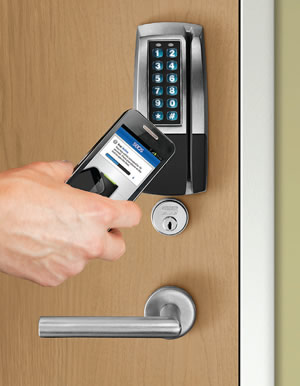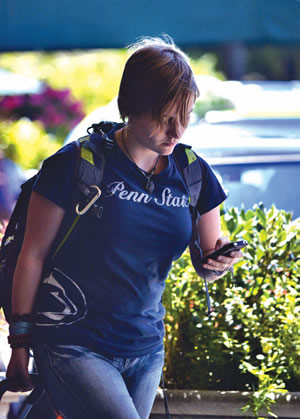The Buzz On NFC
- By Michael Fickes
- 02/01/15

PHOTO COURTESY OF / © ASSA ABLOY, INC.
Near field communication, or NFC, technology is catching on as a tool at some colleges and universities, but not others.
A few years ago, the emerging NFC industry organized a handful of pilot tests at several universities. All more or less proved the technology useful, but not many led to campus-wide use thanks to implementation difficulties.
What is NFC? How does it work? What does it do? What colleges and universities are using it? What is so difficult about implementing NFC?
NFC is a form of very short distance electronic communication. Short distances in the NFC world mean really short — a few centimeters at most. Sometimes, NFC devices must touch to communicate.
The communication occurs by magnetic induction. A wire coil connected to an alternating source of current creates a magnetic field around itself. If another wire coil is placed within that magnetic field, it induces a magnetic field in the second coil, which in turn generates an electrical current.
This electrical phenomenon enables NFC devices to send and receive data with very low levels of power — 15 mA — at 13.56 Mhz.
NFC can turn smartphones into access control credentials, electronic keys and payment applications for vending machines and credit card readers. NFC devices can also purchase tickets and store loyalty cards.
While NFC will offer all of these and other services, an NFC infrastructure isn’t ready yet.
On the mobile smartphone side, manufacturers are pretty much ready. According to Englewood, CO-based IHS, a market research firm, approximately 120 million NFC-enabled handsets were delivered in 2012. That handset count will grow to 1.2 billion in 2017, when 62 percent of all handsets sold will be NFC-enabled.
While access control card readers have generally been readied for NFC use, individual retailers, transportation providers and other vendors must ready their payment infrastructure to accept the technology.
Colleges and universities that want to use NFC for campus security applications such as access control must work with manufacturers, mobile-phone service providers and companies called trusted service managers, or TSMs, to implement systems.
What is a TSM? When Apple or Google manufactures a mobile handset, it isn’t yet associated with any service provider, such as AT&T or Verizon. TSMs provision the phones and make them proprietary to individual service providers.
When a college or university wants to use NFC for campus applications such as access control or vending, the provisioning process must include a unique identifier, which the handset’s owner must download. When an NFC handset is presented to another NFC device, the unique identifier tells the system that this is an authorized user.
A number of schools are pilot-testing NFC technology. Quinnipiac University and Tulane University undertook pilots in November of 2013. The University of San Francisco, Arizona State University (ASU) and Villanova University all completed pilot tests several years ago.
What results did the pilot tests produce? Arizona State University’s pilot was typical.
The ASU Pilot
ASU has used card access control to secure doors for residential, classroom and administrative buildings for a number of years. ASU campuses were equipped with more than 4,000 door access control readers, so students, faculty and staff had all grown accustomed to card access doors.
ASU pilot-tested NFC access control credentials on smartphones for three months, from August 2011 through October 2011. The goal of the test was to see if users liked replacing their one cards with NFC-enabled smartphone credentials. If they did like it, how much would it cost to implement NFC? Would it save or cost money compared to the current system?
“Our pilot test went live in a single residence hall with 14 doors and 32 people — including students, community assistants and staff members,” says Laura Ploughe, director of business applications and planning in University Business Services at ASU. (Community assistant is the ASU term for resident advisors.)
Thirty-one people in the test group received phones. Each phone had been provisioned with a unique identifier before being distributed.
“One student used her own phone,” continues Ploughe. “We wanted her to provision her own phone by downloading an app.
She did it with no trouble at all.”
The pilot also tested different kinds of phones. There were 10 BlackBerrys, 10 iPhones and 12 Androids.
The typical procedure for someone entering this particular residence hall was to card in at the outside gate, card into the building itself, key into the appropriate wing of the building and, finally, key into the room. The credentialed phone would unlock all four doors.
After three months, Ploughe surveyed the 32 participants about their experience.
“They said that it was easier and more efficient to have a single mechanism — the phone — to get through all four doors,” Ploughe says. “They also though it was easier to use the phone that they already had in their hand than to dig through a wallet, purse or backpack for a card.
“Ninety percent said they would like to use their smartphones to open all the doors on the campus as well as for other applications such as paying for food at the student recreation center, transit fares, tickets, meal plans and retail.”
Perhaps more important, students often lose their access cards and need replacements, but they rarely, if ever, lose their smartphones. That makes smartphones ideal platforms for student ID credentials.

PHOTO COURTESY OF S. WONG
Despite the success of the pilot, ASU has decided to wait to implement the technology across campus. “While we proved that the technology would work and that students would like it, among the lessons learned was that it remains an immature technology,” Ploughe says. “We have 76,000 students that would need a secure ID. To manage that, we would have to work with all of the manufacturers and service providers plus their TSMs. We would have to know what kind of phone each user has and make sure the right TSM sets up the ID.
“I think that we need to retain a single management source for this work.
“As for costs, our cost study showed that we would save in card consumables and labor at our different campuses. The financial savings totaled $750,000 to $1 million — but that was before we factored in the work that we would have to do acquiring secure IDs. After looking at that, we didn’t think there would be a return on investment.”
Ploughe sums up by saying she is looking forward to an industry that matures in the future and makes it possible to take advantage of the clear benefits NFC technology does offer.
Villanova University Implements NFC
Villanova, on the other hand, followed up its successful pilot test with a campus-wide rollout of its NFC system. “About 3,557 people are using the system,” says Kathy Gallagher, director, university card systems with Villanova. “We’ve had more than 100,500 access control transactions in the last three months.”
While more and more students, faculty and staff are signing up, not everyone uses the system. In all, Villanova has about 10,000 undergraduate and graduate students and 3,000 faculty members and staff. There are no plans to do away with the school’s plastic Wildcard one card, which remains the official identification document.
All told, the Villanova NFC network spans more than 2,500 locations, including all of the residence halls and approximately 600 laundry machines and 200 vending machines.
For others interested in adopting NFC, Gallagher advises starting with a small pilot program. “Make sure you understand how to administer the system before rolling it out across campus,” she says. “You work out how to issue instructions for using the system, how to troubleshoot problems and how to make sure that the smartphone technologies and operating systems used on your campus will work with your NFC infrastructure.”
Villanova has gotten all of that right, and students and staff like the system. Visitors like it, too. “Everyone wants NFC,” Gallagher says. “It is a hot topic. We hear a lot of stories about student visitors that see how it works, download the app and try to use it to access doors back on their campus. When it doesn’t work, they complain and urge their administrators to implement NFC.”
This article originally appeared in the issue of .